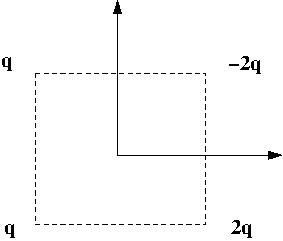|
|
[NOTE/EM-02014] Flux of Feld of a Point ChargeNode id: 5959article |

|
23-10-12 19:10:58 |
n |
|
|
[NOTES/EM-02013] Solid AngleNode id: 5958pageIn this section the concept of solid angle is defined as a generalization of angle in plane geometry
|

|
23-10-12 17:10:14 |
n |
|
|
[NOTES/EM-02009] Line Integrals In PhysicsNode id: 5955pageA few examples of problems are given from electromagnetic theory and other areas of physics are given in which the line integral appears.
|

|
23-10-12 17:10:01 |
n |
|
|
[NOTES/EM-02007]-Maxwell's Equations for Electrostatics-INode id: 5579pageThe Gauss law of electrostatics follows from the Coulomb’s law for a point charge and superposition principle. The Gauss law along with the Gauss divergence theorem of vector calculus imply Maxwell’s first equation \(\nabla\cdot\bar{E}=\rho/\epsilon_0\) for electrostatics
|

|
23-10-10 20:10:14 |
n |
|
|
[NOTES/EM-02008]-Maxwell's Equations for Electrostatics-IINode id: 5580pageThe Gauss law of electrostatics follows from the Coulomb's law for a point charge and superposition principle. The Gauss law along with the Gauss divergence theorem of vector calculus imply Maxwell's first equation \[ \nabla\cdot\bar{E}=\frac{\rho}{\epsilon_0}. \] for electrostatics.
|

|
23-10-10 20:10:28 |
n |
|
|
[NOTES/EM-02006]-Proof of Gauss LawNode id: 5578pageThe Gauss law of electrostatics follows from the Coulomb’s law for a point charge and superposition principle. The proof given here follows Feynman’s lectures. It makes use of two important features of the electric field due to a point charge. These are
(i) the magnitude of the field obeying the inverse square law, and
(ii) radial direction of the electric field of a point charge. The above two properties are essential to the proof. Gauss law will not hold for hypothetical field, not having both the properties.
|

|
23-10-09 04:10:51 |
n |
|
|
[NOTES/EM-02004]-Applications of Gauss LawNode id: 5570pageGauss law is applied to compute the electric field for several systems, see the Table of Contents for details. The symmetry of the problem is used in a nontrivial manner to arrive at the answers for the electric field.
|

|
23-10-07 05:10:29 |
n |
|
|
[NOTES/EM-02003]-Electric Field due to Continuous Charge DistributionsNode id: 5568pageElectric field due to several charge distributions, listed in the table of contents, is computed using Coulomb’s law.
|

|
23-10-07 05:10:47 |
n |
|
|
[NOTES/EM-02002]-Line, Surface and Volume Charge DistributionsNode id: 5566pageContinuous charge distributions spread over a line, or a surface, or volume, are introduced. The electric field due to a continuous charge distribution is obtained by dividing the charge distributions into infinitesimal elements, and summing over electric fields due to the small elements. The computation can often be simplified by making use of symmetries of the problem.
|

|
23-10-07 05:10:31 |
n |
|
|
[NOTES/EM-02001] -Coulomb’s Law and Electric FieldNode id: 5564pageCoulomb’s law is stated for electric field of a point particle. For several point charges the field is obtained as a vector sum of the fields of individual charges
|

|
23-10-07 05:10:39 |
n |
|
|
[NOTES/EM-02005] Flux of $\bar{E}$ and Using Gauss lawNode id: 5577pageThe flux of electric field is defined and As a simple example, the flux of the electric field due to a point charge at the center of a sphere is explicitly computed. Other cases are briefly mentioned an statement of Gauss law is given.
|

|
23-10-02 12:10:31 |
n |
|
|
[NOTES/EM-01011] $\vec B$ vs $\vec H$ --- Naming convention.Node id: 5953pageWe will call \(\vec B\) field as magnetic field when no medium is present.\\ In presence of a magnetic medium, \(\vec B\) will be called magnetic flux density or magnetic induction. The field \(vec H\) will called magnetic intensity or magnetic field intensity
|

|
23-09-30 03:09:36 |
n |
|
|
[NOTE/EM-01008] How are Fields Produced?Node id: 5951pageA brief overview of how electric and magnetic fields produced.
|

|
23-09-30 03:09:15 |
n |
|
|
Finite Dimensional Vector Spaces --- Notes for Lectures and Problems [VS-MIXED-LOT]Node id: 4692collection |

|
23-09-15 12:09:11 |
n |
|
|
[QUE/EM-02057] Field of HemisphereNode id: 5949pageFind the electric field due to a uniformly charged hemisphere of radius \(R\) at the north pole.
|

|
23-08-02 12:08:17 |
n |
|
|
[QUE/EM-02005] Field due to charges on a squareNode id: 5948pageFind the direction and magnitude of $\vec{E}$ at the center of a square with charges at the corners as shown in figure below. Assume that $ q= 1\times 10^{-8}$coul, $a=5$cm

|

|
23-07-31 23:07:45 |
n |
|
|
[QUE-SOL/EM-01001] Solution Node id: 5947page |

|
23-07-07 06:07:42 |
n |
|
|
[WART/EM-01011] 1855 Experiment on Measurement of 'c' by Weber and KohlrauschNode id: 5946page |

|
23-06-20 01:06:40 |
n |
|
|
[WART/EM-01010] Moton o f Charged Particles in Electric and Magnetic FieldsNode id: 5945article |

|
23-06-14 11:06:30 |
n |
|
|
[QUE/EM-02024] Electric Field of a Cylindrical Shell Node id: 5944pageThe electric field is to be computed at a point $P$ on the axis of a thin cylindrical shell having uniform surface charge density $\sigma$. Divide the shell by planes perpendicular to the axis, and using the expression for a electric field due to a uniformly charged ring, write expressions for the field as an integral.

Compute the integral for the cylindrical shell and show that the field due to the cylindrical shell is given by $$ E = \frac{Q}{4\pi\epsilon_0}\frac{1}{(b-a)}\left(\frac{1}{\sqrt{a^2+R^2}}-\frac{1}{\sqrt{ b^2+R^2}}\right) $$ where \(Q\) is the total charge on the cylinder.
|

|
23-06-11 20:06:28 |
n |